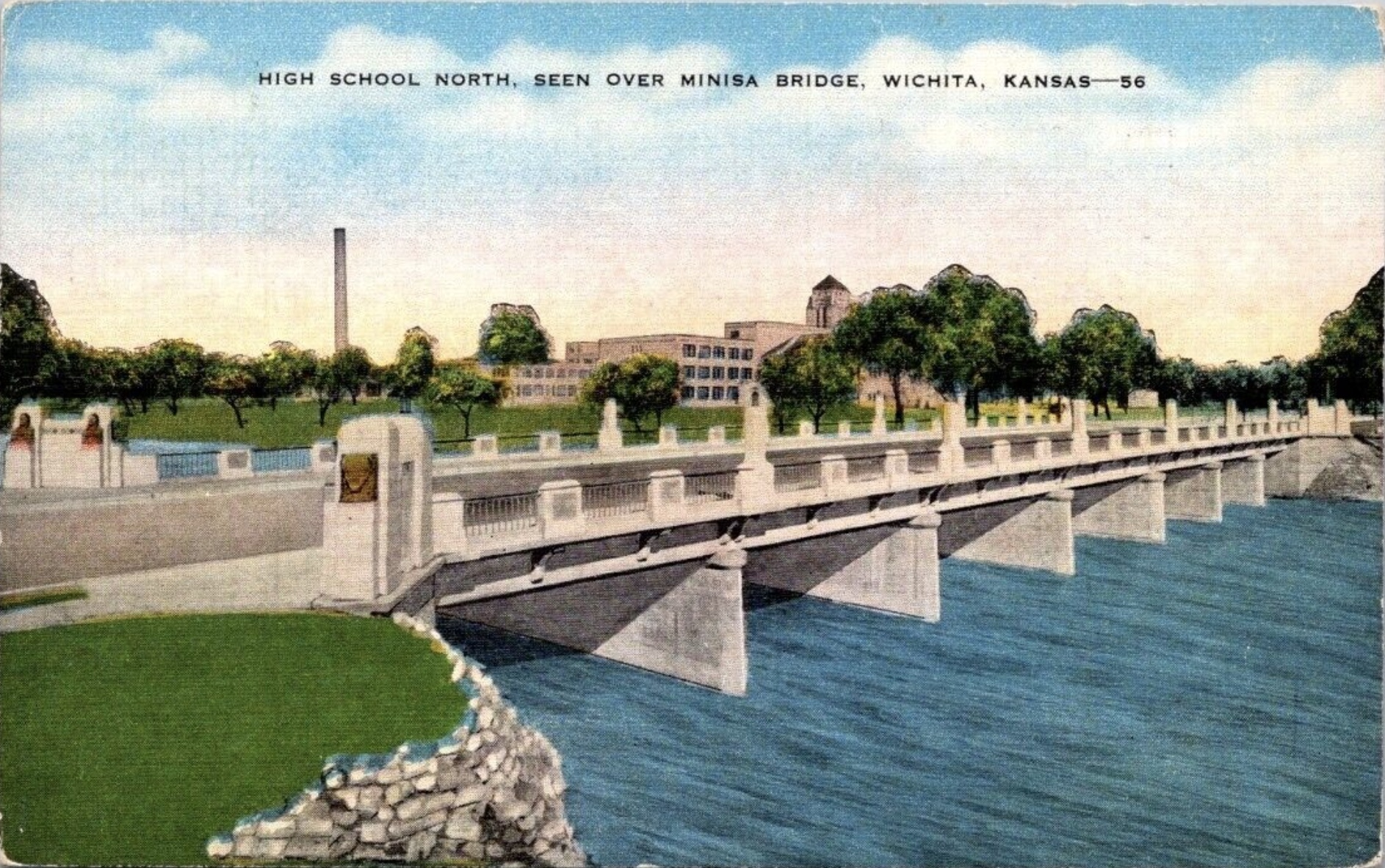Since the day Wichita’s North High School opened in 1929, accolades for its distinctive design, particularly the Indian and pioneer sculptures, have gone to architect Glen Thomas and internationally-recognized fine artist Bruce Moore. A third name, that of Lawrence Byers, if mentioned, is typically incidental. Yet, as the draftsman and iconographer in Thomas’ office, Byers is the one who originated and colorized the designs, setting them to paper for presentation to the school board and, ultimately, for Moore’s recreation.
Misinformation about the nearby Minisa Bridge — who designed and/or created the bas relief Indian sculptures and panels that decorate it — is also repeated in many sources. Some wrongly credit artist Moore with the design. Others incorrectly cite Thomas, while a scant few recognize Byers was responsible.
One credible source of information on the school is “History and Traditions of Wichita High School North,” a booklet written by Ronnie Broshears and Howard McCoy and printed by North’s Printing Department in 1957. Here’s what it says about Byers:
“The idea for the Indian and Pioneer theme, which is expressed on the exterior of the building, was drawn up in the original plans. Lawrence Byers was instrumental in this part of the designing. It was Bruce Moore, a former Wichita High School graduate, who constructed the small-scale plaster models of those figures which were to be used. The full-sized figures were developed by the Terra Cotta Ornamental Works.”
Mystery man
I have been able to find little information on Byers. According to his answers on the 1930 United States Federal Census, Byers did not attend school. Now, whether his answer of no to the attended school question means no high school or no technical school or no school at all remains unknown. In any case, Byers was 19 when Thomas hired him, evidently impressed with the young man’s artistic ability and potential to become a skilled draftsman.
By 1927, 22-year-old Byers was in charge of the office and working with Thomas to plan North High. Byers can rightfully be called an artist as well as a draftsman.
Here, an understanding of iconography helps clarify Byers’ work. Merriam-Webster defines an iconographer as “a maker of figures or drawings especially of a conventional type” and a “student of iconography,” which is itself described as “the traditional or conventional images or symbols associated with a subject and especially a religious or legendary subject.”
Architect Thomas fully recognized Byers’ contributions to the North project and was not reticent about crediting him. In a 1929 Wichita Magazine article, written by Thomas about the new high school, he singled out Byers:
“The thoughts, ideas, suggestions and study of all the men in my office, and especially those of Lawrence W. Byers, were combined to develop what we hoped would be distinctive, modern, and interestingly American.”
A persistent teacher
The best source for information about how the Minisa Bridge came to look the way it does is Ethel Crawford Parker, who taught English at North.
According to an unpublished 1957 paper that was either written or dictated by her, the idea for the bridge came to her “in the spring of 1931 at the annual Water Festival at High School North” when she “caught sight of the rusty steel beams of the old bridge spanning Little River at Thirteenth [that] spoiled the view in that direction.” Why not, she wondered, “have a bridge with architecture and motifs like those of the school building!”
After being rebuffed by the school’s principal and vice principal, Parker took her idea to school district administrators and city officials, who liked it. Parker, who was tasked with the job of coming up with possible names for the bridge, consulted several prominent members of the community. One was Thurlow Lieurance, dean of the Wichita University Music School and composer of a symphony piece titled “Minisa.”
A musical name
North students were given final say and picked Minisa, which means “red water at sunset” in a Native American language.
Both Parker and Byers were mentioned in a Wichita Eagle article about the bridge’s dedication in 1932, although not as prominently as Moore or Lieurance. Thousands of people attended the ceremony.
North principal Grover C. Dotzoiur, who’d originally dismissed Parker’s idea for the bridge, was the closing speaker, remarking:
“A name was sought that would have significance in relation to the Indian or to the pioneer motif. Minisa was chosen because of its euphony, because of its Indian origin and because of the meaning of the word—red water at sunset—and because in Wichita, Minisa has come to be associated with Indian lore through the life and works of Wichita’s own musical composer, Thurlow Lieurance.”
The bridge had already been in the planning stages prior to Parker’s idea for its design modification and Byers’ execution of them.
Interestingly, the bridge might have looked quite different. According to Parker’s paper, city officials sent blueprints for the bridge to Thomas’ office so that the suggested decorative motifs could be added. “Since Glen Thomas was absent from the city, his assistant, Lawrence Byers, drew two sets of plans for the bridge. One carried out the pioneer theme and the other the Indian motifs.”
North High students chose the latter.
Lynn Stephan is a former advertising executive and North High grad (class of ’60) who is working on a book about the school.









